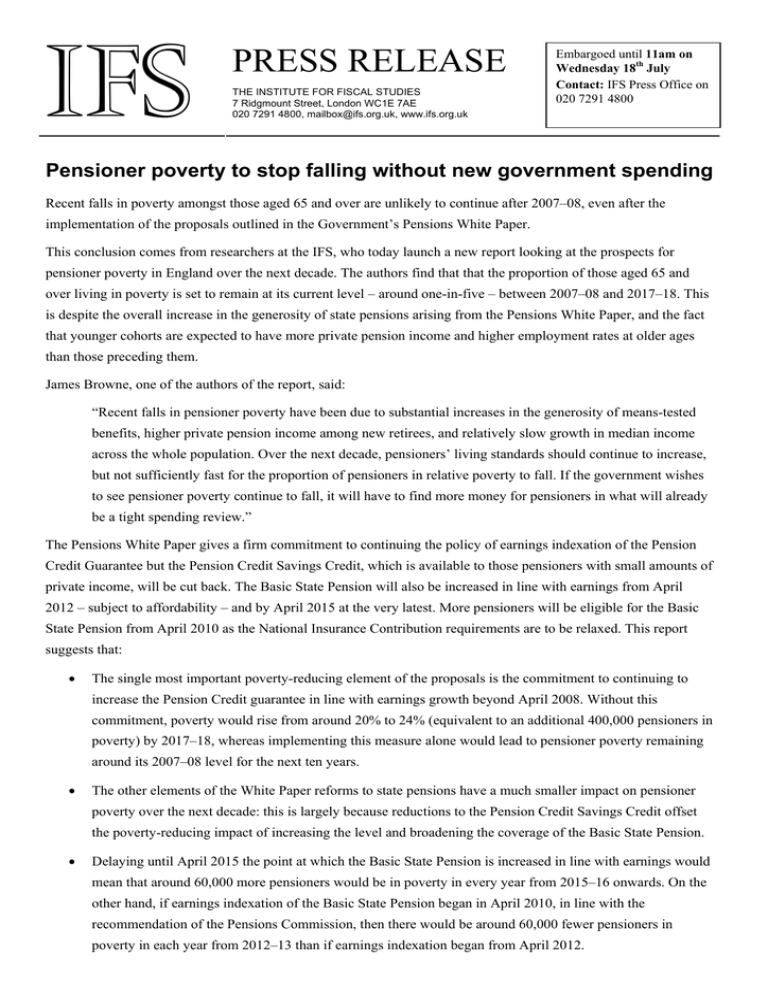IFS PRESS RELEASE
advertisement

IFS PRESS RELEASE THE INSTITUTE FOR FISCAL STUDIES 7 Ridgmount Street, London WC1E 7AE 020 7291 4800, mailbox@ifs.org.uk, www.ifs.org.uk Embargoed until 11am on Wednesday 18th July Contact: IFS Press Office on 020 7291 4800 Pensioner poverty to stop falling without new government spending Recent falls in poverty amongst those aged 65 and over are unlikely to continue after 2007–08, even after the implementation of the proposals outlined in the Government’s Pensions White Paper. This conclusion comes from researchers at the IFS, who today launch a new report looking at the prospects for pensioner poverty in England over the next decade. The authors find that that the proportion of those aged 65 and over living in poverty is set to remain at its current level – around one-in-five – between 2007–08 and 2017–18. This is despite the overall increase in the generosity of state pensions arising from the Pensions White Paper, and the fact that younger cohorts are expected to have more private pension income and higher employment rates at older ages than those preceding them. James Browne, one of the authors of the report, said: “Recent falls in pensioner poverty have been due to substantial increases in the generosity of means-tested benefits, higher private pension income among new retirees, and relatively slow growth in median income across the whole population. Over the next decade, pensioners’ living standards should continue to increase, but not sufficiently fast for the proportion of pensioners in relative poverty to fall. If the government wishes to see pensioner poverty continue to fall, it will have to find more money for pensioners in what will already be a tight spending review.” The Pensions White Paper gives a firm commitment to continuing the policy of earnings indexation of the Pension Credit Guarantee but the Pension Credit Savings Credit, which is available to those pensioners with small amounts of private income, will be cut back. The Basic State Pension will also be increased in line with earnings from April 2012 – subject to affordability – and by April 2015 at the very latest. More pensioners will be eligible for the Basic State Pension from April 2010 as the National Insurance Contribution requirements are to be relaxed. This report suggests that: • The single most important poverty-reducing element of the proposals is the commitment to continuing to increase the Pension Credit guarantee in line with earnings growth beyond April 2008. Without this commitment, poverty would rise from around 20% to 24% (equivalent to an additional 400,000 pensioners in poverty) by 2017–18, whereas implementing this measure alone would lead to pensioner poverty remaining around its 2007–08 level for the next ten years. • The other elements of the White Paper reforms to state pensions have a much smaller impact on pensioner poverty over the next decade: this is largely because reductions to the Pension Credit Savings Credit offset the poverty-reducing impact of increasing the level and broadening the coverage of the Basic State Pension. • Delaying until April 2015 the point at which the Basic State Pension is increased in line with earnings would mean that around 60,000 more pensioners would be in poverty in every year from 2015–16 onwards. On the other hand, if earnings indexation of the Basic State Pension began in April 2010, in line with the recommendation of the Pensions Commission, then there would be around 60,000 fewer pensioners in poverty in each year from 2012–13 than if earnings indexation began from April 2012. Researchers at IFS also considered other reforms that the current or future government could introduce in addition to those in the White Paper: • Making the Basic State Pension universal – i.e. based on residence or citizenship rather than past National Insurance Contributions – for all those aged over the State Pension Age would reduce poverty among those aged 65 and over by 500,000 at a cost of around £7bn annually. Alternatively, if the government could not afford this outlay immediately, it could introduce this policy only for those reaching State Pension Age after April 2012. By 2017–18 this would reduce pensioner poverty by around 50,000, at a cost of £1.9bn, per year. • Increasing the Basic State Pension to the level of the Pension Credit Guarantee would reduce poverty by around 600,000 in 2017–18, and cost around £8.3bn each year. In general, increasing the number of pensioners eligible for a full Basic State Pension is more targeted on pensioners in poverty than increasing the level of the Basic State Pension. But these two reforms could even be introduced together – paying a much more generous Basic State Pension universally – and this would more than halve the rate of pensioner poverty by 2017–18, but be very expensive, costing around £20bn each year. • Even though take-up rates of Council Tax benefit are relatively low amongst pensioners, cuts to Council Tax bills for households containing someone aged 65 or over would not significantly reduce the rates of pensioner poverty. • Higher income tax allowances for pensioners would benefit hardly any pensioners in poverty, because these pensioners have too little income to be liable to income tax. However, scrapping the additional tax allowance currently received by those aged 65 or over would increase pensioner poverty as it would bring some pensioners just above the poverty line into poverty as a result of having to pay income tax. The researchers also showed that poverty could be reduced by 500,000 if all pensioners took up the means-tested benefits to which they are entitled. However, given the current structure and rules of means-tested benefits, this does not seem to be a viable policy that the government could introduce. The report does not estimate the direct costs of bringing about higher take-up, whether on changes to the Pensions Service administrative systems, increased advertising, or more funding for face-to-face advice, for example. ENDS Notes to editors: 1. ‘Pensioner poverty over the next decade: what role for tax and benefit reform?’ by Mike Brewer, James Browne, Carl Emmerson, Alissa Goodman, Alastair Muriel and Gemma Tetlow is published on Wednesday 18th July 2007. The report will be launched at IFS at 11am on 18th July 2007. Please contact the IFS press office on 020 7291 4800 if you wish to attend. 2. The authors use a newly-developed demographic simulation model and the IFS tax and benefit microsimulation model, TAXBEN, to project the private incomes of individuals aged 65 and over in England up to 2017–18. This allows them to simulate the number of individuals aged 65 and over with incomes below 60% of the median, a common measure of relative poverty, under a variety of policy scenarios. As the report is based on a survey of old people in England, all results apply only to pensioners in England. The UK population aged 65 and over is about 20% higher than the English one, so the costs and benefits of extending these policies across the UK are likely to be around 20% higher than those reported here. This release and the report use “pensioner poverty” to mean “poverty amongst individuals aged 65 or over”. The definition of poverty used in the report is slightly different from that used in the official HBAI series in that it depends upon income at the family level, not the household level. All incomes are measured before housing costs (BHC). 3. The research was funded by Help the Aged with co-funding from the Economic and Social Research Council through both the research grant ‘Inequalities in health in an aging population’ (RES-000-23-0590) and the Centre for the Microeconomic Analysis of Public Policy at IFS (grant number M535255111).






